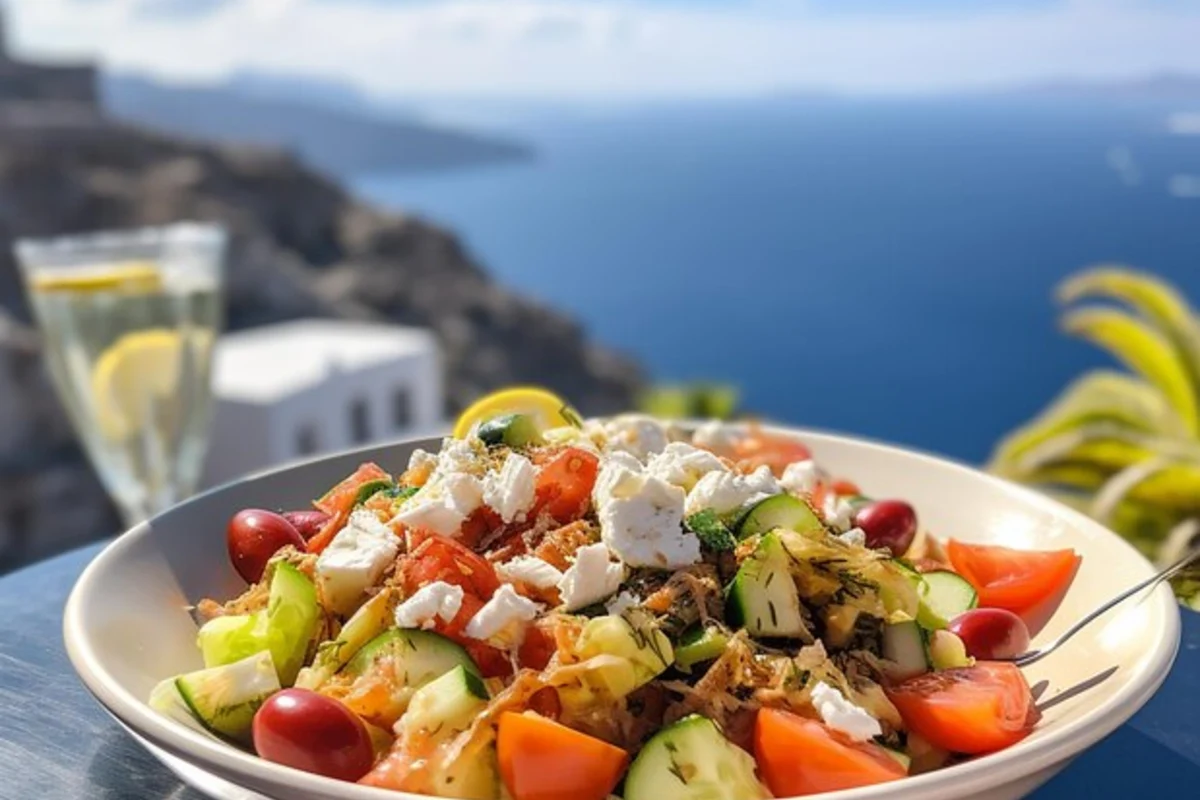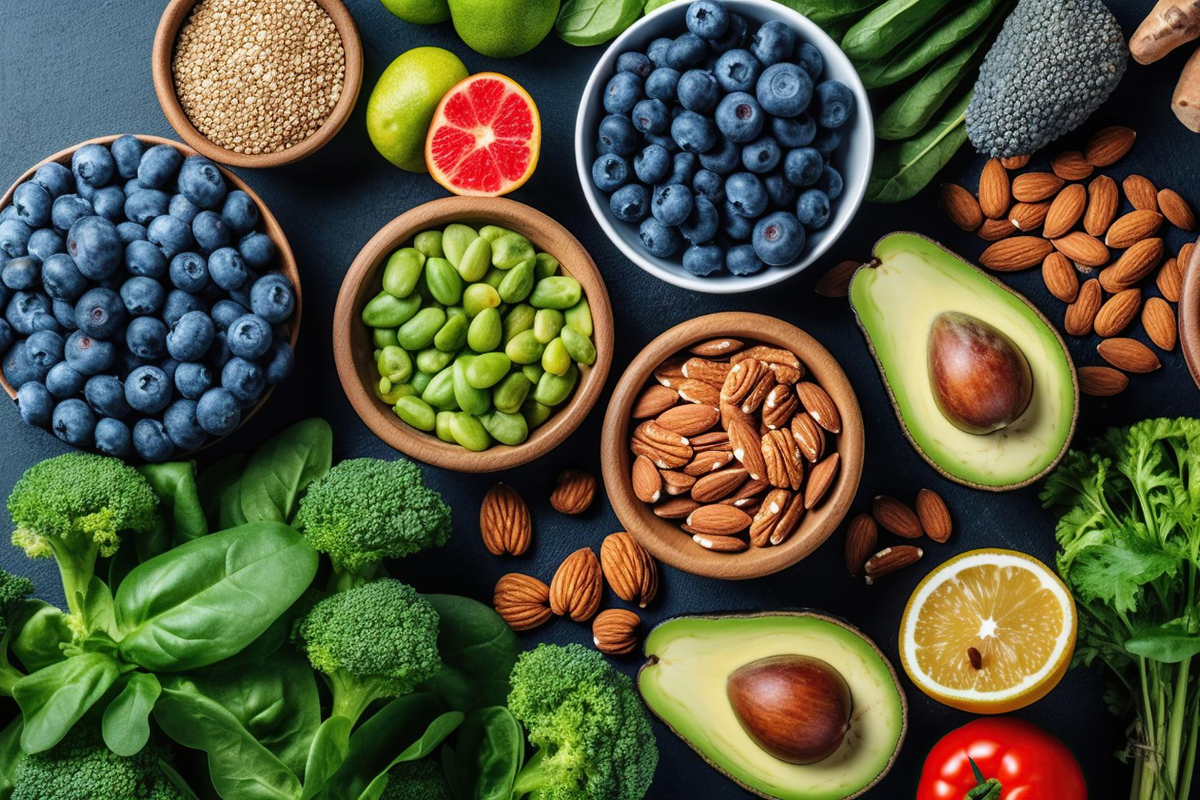What Is The South Beach Diet?
The South Beach diet is a famous diet plan developed in the mid-1990s by cardiologist Dr. Arthur Agatston. While it was originally intended to minimize heart disease risk, it quickly acquired popularity for its weight loss benefits.

The diet emphasizes the importance of selecting the right carbs and fats. It promotes the intake of ‘good carbs’ that are found in whole grains, fruits, and vegetables, and ‘good fats’ that are found in lean meats, olive oil, and canola oil. The diet also warns against ‘bad carbs’ like white bread and sugar and ‘bad fats’ like butter and high-fat cheeses.
Trivia
The South Beach Diet got its name from Miami’s South Beach as it was developed there by Dr. Arthur Agatston.
The South Beach diet follows a phased approach for better sustainability. You can learn more about that in the coming section.
How Does The South Beach Diet Work?
The South Beach diet places a significant emphasis on managing hunger by adopting a structured approach to meals. It works by dividing meals into three distinct phases that not only help with weight loss but also help individuals transition into a healthier lifestyle.
The phases are designed to boost your confidence by showcasing early results, increasing motivation, and instilling long-term habits. Here is a detailed look at the three phases of this diet.
Unveiling the Three Phases of the South Beach Diet
Phase 1: Commencing Your Weight Loss Odyssey
Duration: A fortnight
Objective: Eradicate yearnings for saccharine edibles and stabilize glucose levels, expediting weight loss.
Edibles: Poultry, seafood, tofu, eggs, diminished-fat cheese, legumes, and non-starchy verdure.
Meal Cadence: Three equilibrated repasts daily, accompanied by sweet courses, and interposed with snacks.
Foods to Spurn: Bread, rice, spuds, pasta, confections, fruits, and spirits.
Note: Snacking is endorsed to thwart excessive indulgence.
This inaugural phase serves as a catalyst to recalibrate the body’s metabolic processes, fostering fat combustion while abating sugar and starch hankerings. An integral juncture in the weight loss expedition.
Phase 2: Attaining the Desired Pinnacle
Duration: Persists until the coveted weight is achieved
Objective: Gradually reintegrate “beneficial” carbohydrates while perpetuating a steadfast weight reduction.
Rate of Weight Descent: Approximately 1 to 2 pounds weekly.
Carbohydrate Reintegration: A gradual process, appending one carbohydrate serving per week and monitoring physiological reactions.
Prudent Carbs: Fruits, select whole-grain commodities, supplementary vegetables, indulgences, and brown rice.
Observation: Scrutiny of vitality, disposition, slumber quality, dermal conditions, and gastrointestinal movements.
Adjustment: Temporarily revert to Phase 1 if necessary to regain mastery.
The subsequent phase of the South Beach diet is tailored for consistent weight reduction. It reintroduces ‘beneficial carbs’ into the regimen, sustaining progress initiated in Phase 1 by incorporating nutrient-laden carbohydrates. This strategy underpins the diet’s sustainability.
Phase 3: Embracing a Wholesome Lifestyle
Duration: Uninterrupted, for weight maintenance
Objective: Cultivate a sustainable, salubrious lifestyle encompassing all victuals in moderation.
Approach: Exercise discernment in culinary selections, experiment with novel recipes and constituents, and relish a harmonized diet.
Sustenance: Uphold the desired weight and prioritize enduring well-being.
Flexibility: Should individuals experience weight resurgence or carb longings, they can revisit Phase 1 for restriction or Phase 2 to appease cravings, as needed.
The ultimate phase of the South Beach diet accentuates transitioning from adherence to a diet regimen to instituting a perennial lifestyle transformation. This facilitates individuals in forging a balanced approach to nourishment, fortifying overall well-being.
Should you have traversed this narrative thus far, you are undoubtedly contemplating the initiation of this dietary voyage. The subsequent section shall unravel the pertinent details.
A Practical Guide to Initiating the South Beach Diet
Let’s navigate through the initiation of the South Beach Diet with finesse, unveiling key steps and strategies that can pave the way for a successful, enduring journey towards enhanced well-being and weight management. This pragmatic guide unfolds as follows:
1. Curate Your Culinary Arsenal
Establish culinary preparedness by amassing all essential ingredients aligned with the South Beach Diet. Eliminate non-compliant foods from your kitchen, erecting a barricade against succumbing to cravings.
2. Chronicle Your Culinary Odyssey
Chronicle your gastronomic exploits through a food journal. This aids in comprehending your inclinations and triggers, discerning which edibles evoke well-being and which beckon cravings or overindulgence.
3. Craft an Exercise Symphony
Deliberate on an exercise regimen that genuinely captivates you. Shatter limitations and explore a plethora of activities that kindle your sense of vitality and engagement.
4. Decode Ingredient Almanacs
Ingrain the habit of scrutinizing ingredient lists while navigating the aisles of food procurement. This conscientious practice empowers you to make informed choices aligned with the South Beach Diet’s principles.
5. Govern Your Gastronomic Quantities
Exercise mindfulness concerning portion sizes to uphold wholesome eating habits.
Recall that the South Beach Diet is not merely a fleeting scheme but an encompassing transformation of lifestyle. Execute these steps with a gradual cadence, laying the foundation for a triumphant and enduring journey toward heightened well-being and weight management.
The Gastronomic Mosaic: A Sample South Beach Diet Menu
In the ensuing segment, we will traverse a hypothetical diet menu, offering a mosaic of gastronomic delights from distinct phases.
Breakfast
- Phase 1: Bask in the symphony of two scrambled eggs accompanied by the verdant allure of spinach and the savory embrace of smoked salmon.
- Phase 2: Indulge in a harmonious blend of a pita slice adorned with two eggs, spinach, and a moderated infusion of feta cheese.
- Phase 3: Savor the crescendo of mini crustless quiches, entwined with a slice of whole-grain toast, a cup of berries, and the comforting companionship of black coffee or tea.
Quick Insight: The inception of smoothies is intricately interwoven with the advent of the blender in 1922, heralding an era where these delectable concoctions remained in obscurity in the United States.
Lunch
- Phase 1: Relish a symphony of flavors with a vegetable salad adorned by the succulence of grilled scallops, accompanied by the refreshing notes of iced tea.
- Phase 2: Partake in a bowl of verdant freshness with a dash of curried turkey.
- Phase 3: Delight in a green salad ensemble featuring the elegance of salmon or chicken, drizzled with the golden elixir of olive oil and vinegar.
Dinner
- Phase 1: Satisfy your palate with a lone serving of grilled tuna, surrounded by the medley of grilled vegetables and a side salad.
- Phase 2: Indulge in a solitary serving of Louisiana-style shrimp and rice, escorted by the presence of baked tomatoes.
- Phase 3: Revel in the array of roasted vegetables such as zucchini, squash, and red onion, a petite portion of your preferred lean meat (be it salmon or chicken), and a serving of robust grains like barley or quinoa.
Dessert
- Phase 1: Conclude your culinary odyssey with a solitary slice of ricotta cheesecake or the cool embrace of chilled espresso custard.
- Phase 2: Culminate in the decadence of a slice of South Beach diet-style tiramisu.
- Phase 3: Relish a tablespoon of Mascarpone cheese coupled with a serving of Greek yogurt adorned with peaches, crowned with slivered almonds and a dusting of cocoa powder.
Snacks
Throughout the day, indulge in plain Greek yogurt accented with fresh dill and lemon juice, celery sticks harmonizing with peanut butter, assorted vegetables accompanied by cilantro and pesto dip, or almonds. Bear in mind that the magnitude of portions and meal selection hinges on individual dietary requisites.
Analyzing the Merits and Demerits of the Southern Shore Diet
Advantages
Potential Enhancement of Cardiovascular Well-being: The Southern Shore regimen prioritizes heart-friendly fare such as piscine selections, verdant produce, and wholesome lipids. These choices may mitigate the likelihood of coronary heart maladies. An examination spotlighted in the Journal of the American College of Cardiology affirms that substituting saturated fats with unsaturated counterparts markedly diminishes the peril of coronary heart ailments (1).
Facilitation of Weight Reduction: In a study spanning 12 weeks, participants afflicted with metabolic syndrome experienced an average weight loss of 11 pounds and a 2-inch reduction in waist circumference by adhering to the Southern Shore regimen. The initial fortnight followed Phase 1, with Phase 2 constituting the subsequent study duration (2).
Curbing Appetite: Emphasizing comestibles rich in fiber and intricate carbohydrates while vehemently eschewing simple or refined carbohydrates is a focal point of the diet. Research indicates that diets abundant in refined carbohydrates may exacerbate hunger by augmenting ghrelin, the hunger-inducing hormone (3).
Normalization of Blood Glucose Levels: Post the inaugural phase, the Southern Shore diet advocates the consumption of high-fiber fare, whole grains, and intricate carbohydrates. This practice can contribute to the stabilization of blood sugar levels and the reduction of insulin resistance—a metabolic condition impeding the regulation of blood sugar levels. A study demonstrated that adherence to the Southern Shore regimen led to decreased fasting insulin levels, indicative of improved blood sugar control (2).
Advocacy for Wholesome Dietary Habits: The regimen aligns with general precepts of healthy nutrition, accentuating the intake of whole grains, vegetables, lean proteins, and salubrious lipids. Such an approach aids individuals in cultivating durable, health-promoting habits.
Drawbacks
Stringent Inception Phase: The initial phase of the Southern Shore regimen proves notably restrictive, eliminating a multitude of consumables. This stringency may pose adherence challenges, potentially leading to withdrawal symptoms.
Heavy Reliance on the Glycemic Index: The diet leans heavily on the glycemic index, a metric that can be intricate and occasionally inaccurate in forecasting the impact of foods on blood sugar levels.
Lack of Prescribed Structure: The plan lacks explicit directives on reintegrating carbohydrates into the diet, leaving this facet to individual discretion. This ambiguity may pose challenges for some adherents.
Potential Financial Impediment: The cost of availing the Southern Shore diet’s meal delivery service may be relatively steep, necessitating supplementary expenses for fresh fruits and vegetables.
Potential Precipitation of Disordered Eating: The diet’s penchant for categorizing foods as either “good” or “bad” based on their carbohydrate and lipid content may induce disordered eating patterns and foster an adversarial relationship with food.
Sanctioning of Artificial Sweeteners: While sugar consumption is circumscribed, the diet permits the usage of artificial sweeteners and diet beverages, linked to conceivable health hazards.
Inadequate Substantiation: Certain assertions in “The Southern Shore Diet” (2003) by Arthur Agatston lack scientific corroboration, casting doubt on the diet’s credibility.
Prudence is imperative when considering any dietary regimen, including the Southern Shore diet. A comprehensive evaluation of its potential benefits and drawbacks is crucial. Consultation with a healthcare professional before embarking on any novel dietary plan is advisable to align with individual health objectives and requisites.
The Southern Shore regimen indeed contributes to weight reduction, but what underpins this mechanism precisely? Delve deeper into the subsequent section for a more nuanced exploration.
How Can I Lose Weight On The South Beach Diet?
The South Beach diet is a popular way to lose weight by focusing on protein and low-GI foods. A study showed that people who followed this diet for 12 weeks lost an average of 11 pounds and 2 inches from their waist. They also improved their fasting insulin and felt more satisfied after eating (2).
The weight loss continues in Phase 2, where you can expect to lose one to two pounds per week. This is a healthy and realistic rate. Of course, your results may depend on how well you stick to the diet, as well as your lifestyle and activity level.
In this article, you have learned how the South Beach diet can help you shed some pounds. Next, we will explore if this diet is safe and effective in the long term.
Is The South Beach Diet Safe And Sustainable?
If you are looking for a way to lose weight and improve your health, you may have heard of the South Beach diet. This popular diet plan was created by cardiologist Dr. Arthur Agatston and claims to help you shed pounds without feeling hungry or deprived. But is the South Beach diet safe and sustainable? Let’s find out.
The South Beach diet is based on the principle of eating the right carbs and fats, rather than avoiding them altogether. It consists of three phases: the first phase is the most restrictive and lasts for two weeks, during which you eliminate most carbs, sugars, and fruits from your diet. The second phase is less strict and allows you to gradually reintroduce some carbs and fruits, as long as they are low on the glycemic index. The third phase is the maintenance phase, where you can eat all foods in moderation, as long as you follow the basic guidelines of the diet.
The South Beach diet aims to help you lose weight by stabilizing your blood sugar levels, reducing your cravings, and increasing your metabolism. It also encourages you to eat more whole foods, vegetables, lean proteins, and healthy fats, while limiting processed foods, refined carbs, and saturated fats. These are all sound nutritional principles that can benefit your health in many ways.
However, the South Beach diet is not without its drawbacks. One of them is that it allows the consumption of processed vegetable oils, such as canola oil, soybean oil, and corn oil. These oils are high in omega-6 fatty acids, which can cause inflammation and increase the risk of chronic diseases. A better option would be to use unprocessed oils that are rich in omega-3 fatty acids, such as avocado oil or extra virgin olive oil. These oils can lower inflammation and protect your heart health.
Another potential issue with the South Beach diet is that it may be hard to sustain for some people. The first phase of the diet can be challenging to follow, as it requires a drastic change in your eating habits and may cause side effects such as headaches, fatigue, or constipation. The second phase can also be tricky to navigate, as you need to monitor your carb intake and choose wisely from a limited list of foods. The third phase may seem more flexible, but it still requires you to follow some rules and avoid certain foods.
The bottom line is that the South Beach diet is generally safe and effective for weight loss, as long as you follow it correctly and make some adjustments to suit your individual needs. However, its sustainability depends on your personal preferences, lifestyle, and goals. The best diet for you is the one that you can enjoy and stick with for life.
Now that you know more about the South Beach diet, how does it compare to another popular low-carb diet: the Keto diet? Find out in the next section.
South Beach Diet Vs. Keto Diet: A Comparison
If you are looking for a low-carb diet, you might have heard of the South Beach and Keto diets. These two diets have some similarities, but also some important differences. Here is a brief overview of what they are and how they compare.
Keto Diet South Beach Diet High in fat, low in carbs High in fiber, low in glycemic index carbs
Includes both saturated and unsaturated fats Includes only unsaturated fats and lean protein
Aims to put the body in a state of ketosis Does not aim for ketosis Both diets can help you lose weight and improve your health, but they have different approaches and goals.
The Keto diet is more strict and requires you to limit your carb intake to very low levels, usually less than 50 grams per day. This forces your body to use fat as its main source of energy, instead of glucose. This process is called ketosis, and it can have various benefits, such as suppressing appetite, boosting metabolism, and improving brain function. However, ketosis also has some risks, such as keto flu, nutrient deficiencies, and increased cholesterol levels. The Keto diet is not suitable for everyone, especially people with diabetes, kidney problems, or heart disease.
The South Beach diet is more flexible and balanced. It allows you to eat more carbs, as long as they are high in fiber and low in glycemic index. These are carbs that do not spike your blood sugar levels too much, such as whole grains and legumes.
The South Beach diet also encourages you to eat healthy fats, such as olive oil, nuts, and fish, and lean protein, such as chicken, turkey, and eggs. The diet has three phases that help you gradually change your eating habits and lifestyle. The first phase is the most restrictive, but it only lasts for two weeks. The second phase is more lenient and lasts until you reach your goal weight.
The third phase is the maintenance phase, where you can enjoy all foods in moderation. The South Beach diet can help you lose weight, lower your cholesterol and blood pressure, control your hunger, and prevent diabetes. However, it can also be challenging to follow, especially the first phase. It may also not be enough for some people who need more carbs for their activity level or medical condition.
The bottom line is that both diets have pros and cons, and there is no one-size-fits-all solution. The best diet for you depends on your personal preferences, lifestyle, health conditions, and goals. Before starting any new diet, it is always a good idea to consult with your doctor or a registered dietitian.








